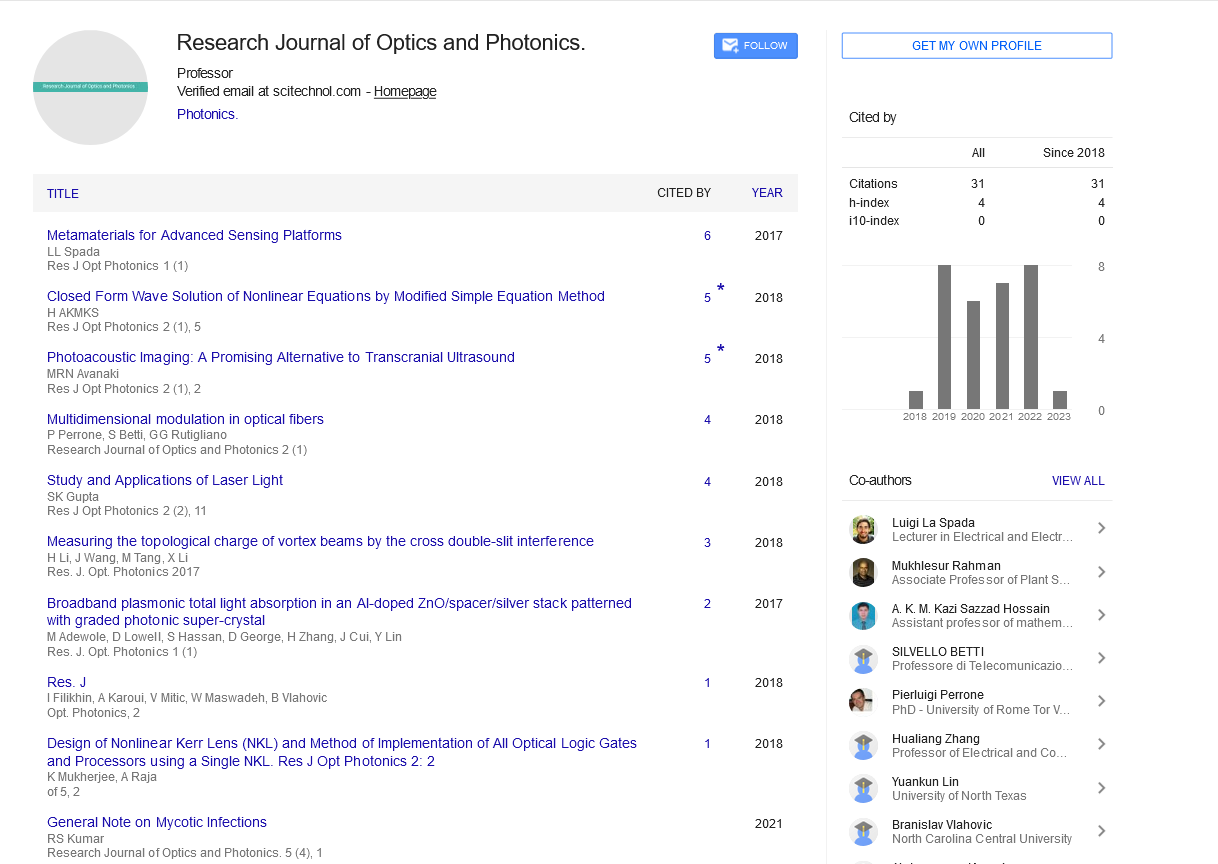Short Communication, J Opt Photonics Vol: 7 Issue: 4
Recent Developments and Trends in Laser Science Technology
Davood Kalhor*
1Department of Science and Technology, University of Damghan, Damghan, Iran
*Corresponding Author: Davood Kalhor,
Department of Science and Technology,
University of Damghan, Damghan, Iran
E-mail: Kalhor@dav.ir
Received date: 22 November, 2023, Manuscript No. RJOP-24-128659;
Editor assigned date: 24 November, 2023, PreQC No. RJOP-24-128659 (PQ);
Reviewed date: 08 December, 2023, QC No. RJOP-24-128659;
Revised date: 15 December, 2023, Manuscript No RJOP-24-128659 (R);
Published date: 22 December, 2023, DOI: 10.4172/RJOP.23.7.1000059.
Citation: Kalhor D (2023) Recent Developments and Trends in Laser Science Technology. Res J Opt Photonics 7:4.
Description
In recent years, significant advancements and emerging trends have reshaped the laser research and applications, paving the way for groundbreaking discoveries and transformative technologies. One of the most notable recent developments in laser sciences is the emergence of high-power, high-repetition-rate laser systems. These advanced laser sources, capable of delivering intense bursts of laser pulses at kilohertz or even megahertz repetition rates, have opened up new possibilities for applications such as ultrafast spectroscopy, precision machining, and laser-driven particle acceleration. Highrepetition- rate lasers enable faster data acquisition and processing, enabling researchers to study dynamic processes with unprecedented temporal resolution and precision [1-3].
Moreover, recent advancements in laser technology have led to the development of compact and portable laser systems for fielddeployable applications. Miniaturized laser sources, such as semiconductor lasers and fiber lasers, offer high performance and reliability in a compact form factor, making them ideal for applications such as lidar remote sensing, medical diagnostics, and defense applications. These portable laser systems empower researchers and practitioners to bring advanced laser capabilities to challenging environments and remote locations. Another significant trend in laser sciences is the integration of lasers with other emerging technologies, such as Artificial Intelligence (AI), Internet of Things (IoT), and nanotechnology. Laser-based manufacturing processes, such as laser cutting, welding, and additive manufacturing, are being augmented with AI-driven optimization algorithms and IoT-enabled monitoring and control systems, leading to greater efficiency, flexibility, and quality in industrial production. Furthermore, the combination of lasers with nanomaterials and nanofabrication techniques enables the precise manipulation and assembly of nanostructures for applications in electronics, photonics, and biomedicine [4-7].
In the field of medical sciences, laser technologies continue to revolutionize diagnosis, treatment, and therapy. Recent developments in laser-based imaging techniques such as Optical Coherence Tomography (OCT) and multiphoton microscopy offer highresolution, non-invasive imaging of biological tissues with subcellular detail, enabling early detection of diseases such as cancer and retinal disorders. Laser-based therapies, including Photodynamic Therapy (PDT) and laser ablation, provide minimally invasive treatment options for various medical conditions, with reduced side effects and improved patient outcomes [8,9].
Furthermore, laser sciences are driving advancements in quantum technologies, with applications in quantum communication, sensing, and computing. Quantum Key Distribution (QKD) systems, based on the principles of quantum mechanics and laser photonics, offer secure communication channels immune to eavesdropping and hacking, enabling encrypted data transmission for sensitive applications such as financial transactions and government communications. Quantum sensors, such as atomic clocks and gravimeters, utilize laser-cooled atoms and precision laser measurements to achieve unprecedented sensitivity and accuracy in measuring physical parameters.
Despite these remarkable advancements, laser sciences also face several challenges and limitations that must be addressed to fully realize their potential. One challenge is the development of robust and reliable laser systems capable of operating in extreme environments, such as space, deep sea, and high radiation environments. Engineering lasers for space missions, for example, requires addressing issues such as vacuum compatibility, thermal management, and radiation hardening to ensure the reliability and performance of laser systems in the harsh conditions of space [10].
Moreover, laser safety and regulatory considerations are of paramount importance in the deployment and operation of laser technologies in various applications. Ensuring compliance with laser safety standards and regulations is essential for protecting personnel, property, and the environment from the hazards associated with laser radiation. Additionally, addressing concerns related to laser-induced eye injuries, laser pointer misuse, and environmental impact is essential for fostering public acceptance and trust in laser technologies.
References
- Hill MR, DeWald AT, Demma AG, Hackel LA (2003) Recent developments in laser peening technology. Adv Mater 578:23-28.
- Yun SH, Adelman RA (2015) Recent developments in laser treatment of diabetic retinopathy. Middle East Afr J Ophthalmol 22:157.
- Uhlenbusch J, Bielesch U, Klein S, Napp M, Schafer JH (1996) Recent developments in metal processing with pulsed laser technology. Appl Surf Sci 106:228-234.
- Legres LG, Chamot C, Varna M, Janin A (2014) The laser technology: New trends in biology and medicine. J Mod Phys 4.
- Ahmad S, Ashraf M, Abid S, Jabbar M (2022) Recent developments in laser fading of denim: A critical review. J Nat Fibers 19:11621-11631.
- Stamm U, Paetzel R, Bragin I (1997) Recent developments in industrial excimer laser technology. Eleventh International Symposium on gas flow high-power laser conference 3092:485-492.
- Alora MB, Anderson RR (2000) Recent developments in cutaneous lasers. LSM 26:108-118.
- Hecht J (2010) Short history of laser development. Optical Engg 49:91002.
- Green MA (2004) Recent developments in photovoltaics. Solar Energy 76:3-8.
- Deckelbaum LI (1994) Cardiovascular applications of laser technology. LSM 436:315-341.
 Spanish
Spanish  Chinese
Chinese  Russian
Russian  German
German  French
French  Japanese
Japanese  Portuguese
Portuguese  Hindi
Hindi 